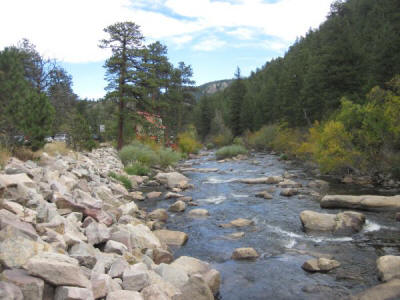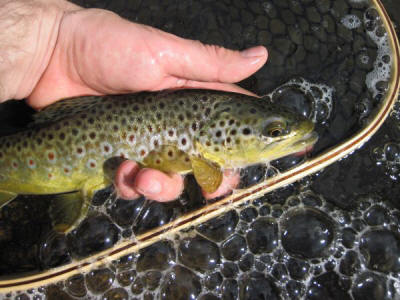The Big Thompson
by Josh Rickard
The Big Thompson River has its start in the high mountains of Rocky Mountain National Park in Forrest Canyon, flows down through the town of Estes Park where it makes a brief stop at Lake Estes, before continuing its journey though the canyon along Highway 34 to Loveland.
The Upper Big T in Rocky Mountain National Park
Looking south from the top of Trail Ridge Road, guests of Rocky Mountain National Park can see the upper sections of Forrest Canyon. This is the start of the Big Thompson River. As it travels downstream, it eventually exits Forrest Canyon were it is joined by Spruce and Fern Creeks. All of Forrest Canyon and the headwater lakes is off trail an extremely difficult hiking and should only be attempted by experienced hikes and backpackers.
True access to the Big Thompson begins in Moraine Park and can be fished upstream along some of various trails out of the area. In Moraine Park, the Thompson splits into several different streams and side channels. Some locals refer to them by different names, but they are all the Big T. Marshy sections can develop at various times of the year during high water or rain. The road through the moraine has various places to pull out and fish. The moraine is very open with little cover. Fishing in this meadow will require a carful approach so you don’t spook the fish. Browns, Rainbows and Brookies can be caught here. If you are willing to take the hike back, you may be lucky enough to find an endangered Greenback Cutthrout. If you are fortunate enough to catch one of these, please handle it with care as it is an endangered fish and making a recovery in the Park. This is a popular destination in the Park and elk are often found in the meadow. You may be unknowingly posed in a picture or two as visitors to the park like to capture a picture of a fly fisherman and elk in the same frame.
The best reference for the Park is Fly Fishing Rocky Mountain National Park by Steve Schwitzer.
As the river exits the park, it runs through various sections of public and private property as it flows to the town of Estes and into Lake Estes. This section can be fished but is generally best to past over for better water.

|
The Canyon Below Lake Estes Along Highway 34
The approximately 9 miles of river below Lake Estes to the Waltonia Bridge is Catch and Release with artificial flies and lures only. The area below Olympus Dam can be accessed by traveling on Mall Road. Upstream of the road is a public park that makes up the tail water. Even though this section stays open all year, it can get crowded, even in the winter. Below the Mall Road bridge is well marked private property.
Following Highway 34 downstream, the river quickly returns and parallels the road. Various pull outs are located along the road and there is a significant amount of public access. Private property should be respected and is well mark. Often times, the side along the road is public but the far bank is private. The locals are friendly and are used to fly fisherman and respect your right to fish the public waters, so please return the favor and respect their property. You can cast all the way across but may only wade to the midpoint.
The river in the canyon is a classic freestone stream: pocket water dominates. Some sections do level out and make some calmer runs, but these are the exception, not the rule. This is good news though, as the river has healthy populations of stoneflies, mayflies and caddis of all types that maintain a large population of healthy trout. The Rainbows and Browns are wild and are generally found in the 10 to 12 inch range. No stocking has occurred in the Big T since the 90’s.

|
Below the Waltonia Bridge, the river eventually runs through the town of Drake, where it is joined by the North Fork of the Big Thompson. The further you move downstream, the gradient of the river tends to increase. The water may be intimidating to some fisherman, but those looking for a little more room on the river will tend to find it in this section.
You will find the Idlewild dam and small lake in the lower section. There is some tempting water upstream of the dam and some large fish are occasionally found here, but I would recommend avoiding this stretch as there is no much water until you hit the private property and fishing in this section tends to be slow. The Lake area does have a nice pull out to stretch and an outhouse can be found here if necessary.
More pocket water and the Viestenz-Smith Park (closed in the winter) are found below Idlewild. Facilities and a park and large picnic area can be found here and is a great place to spend time with the family, but generally a bad place to fish. Park upstream up the park to start fishing. The last four miles, or fist four if you are coming up from Loveland, from Viestenz Smith to the Dam Store located at the mouth of the canyon is dominated by private property and what is termed the Narrows. While the Narrows may be public, be warned that fishing this area has limited access and road rises away from the river, trapping you in between a man made wall and the canyon wall.
The Thompson is a healthy river with a large trout population. Enjoy this great river.
By
Josh Rickard
www.rockymountainflyfisher.com

|
Stream Flows Big Thompson River below Lake Estes



